Issue #88: Versatile Eggplant—Breakfast, Lunch, Dinner, and Even Dessert
Love Letter to My Favorite Vegetable, A Recipe for Roasted Eggplant with Tahini from an Israeli Breakfast Buffet at which I Overindulged
Just back from my trip to the Middle East, Dubai, Abu Dhabi, and Tel Aviv, to be more precise, and boy did I eat well. This week’s recipe is for something I ate three times, three days in a row. More on that in a bit. Coincidentally, the last episode of my What’s Burning podcast welcomed Naama Shefi, founder of both the New York based Jewish Food Society and the Tel Aviv based Asif: Culinary Institute of Israel. I work with Naama on her Asif project, so you may think I’m biased, but it really is something to see, and their café and deli afford a real taste of the country’s cuisine.
The current exhibition on right now at Asif is about the history of Israeli workers’ restaurants that served to satisfy immigrant workers’ needs way beyond sustenance or nutrition and that continue to occupy a place of nostalgia in the collective gastronomic memory of the country. I’ve learned about and even eaten in a few similar places during my travels in Italy and Hungary, but I didn’t know anything about the phenomenon in Israel. A tremendous amount of new research has been conducted for this exhibit. You can read more about it here.

Ok. I’m ready to throw down the gauntlet and declare eggplant my favorite vegetable. There are many contenders, of course. Could be tomato, or cauliflower, or even the humble carrot. But I seem to always gravitate toward eggplant when I see it among its vegetable cousins on a menu.
Within the category of eggplant and eggplant dishes there is tremendous variety. I think of the tiny, bitter, green and white eggplants that populate Thai curries, and the slender, purple Asian eggplants that are blanched in oil and then stir-fried in Sichuan dishes. There are the meaty, fried eggplants of Southern Italy and the smokey, fire-roasted eggplants of the Middle East. I recall the unusual and treasured gift I once received from Cypriot friends, a jar of tiny eggplants preserved in sugar syrup. And there was that surprising dessert at Del Posto years back created by then pastry chef Brooks Headley (now of Superiority Burger fame), for which he combined eggplant, chocolate, and sheep’s milk ricotta in a flaky pastry. Who could forget the most memorable eggplant I ever had as an appetizer at a yakitori place in Tokyo. It was served raw (!) in wedges with miso for dipping, the flesh crisp and sweet like an apple. They told us it was from Osaka. I would never imagine you could eat an eggplant raw. Leave it to the Japanese.
I started this newsletter in Tel Aviv, after spending a week in the UAE. The Middle East loves its eggplant. It arrives at the table in many forms morning, noon, and night: roasted and puréed with tahini (moutabal) or without (baba ganoujh), stewed with tomato, salted and pickled, stuffed with lamb and bulgur.
Although the selection on the breakfast buffet at the quaint Vera Hotel where I stayed in Tel Aviv on this last trip changed a little from day to day, every morning there was a pyramid of roasted eggplant disks sitting in a pool of tahini. (You can spot it in my video of the breakfast buffet, above, just next to the large, round chafing dishes.) I ate more than my share three days in a row. Accordingly, that is the recipe I thought I would share this week to give you a taste of my trip.
Eggplant 101
Look for firm, shiny eggplants. They wrinkle and turn spongy as they age. In general, ignore the ginormous ones.
Because eggplant is in the Nightshade family (more on that below), some people suggest it shouldn’t be refrigerated. I find that you can leave an eggplant at room temperature for a day or two, but any longer and it softens and shrivels up. I prefer to refrigerate mine for longer storage.
No matter the color, the skin is edible, but it isn’t always desirable. It depends on what you are using the eggplant for. The skin softens when cooked and helps hold the flesh intact. Sometimes, I peel away a few strips of the skin, leaving just a little behind for flavor and texture. In fact, I’ve seen chefs use eggplant skin, often charred until black, as an ingredient in and of itself. The first time was in Paris, at Le Chateaubriand, where Iñaki Aizpitarte used the burnt skin of eggplant in a sauce for veal (to mixed effect #imho).
The most important thing to remember about cooking eggplant is to cook it enough. Except for that unusual Osaka eggplant we ate raw, undercooked eggplant will kill any dish. It’s bitter and tough. To appreciate eggplant in all its glory, you need to get past that point when it turns soft and silken. Because cooking times can vary due to ripeness, age, oven temp, and other factors, you, the cook, need to decide when it is done. As I was testing this recipe, my roasted eggplant took a full 15 minutes longer than expected to soften, so I just kept it in the oven. Better to err on the side of overcooked, which may be less attractive, but will be edible, and therefore, delicious.
Back to the Nightshade topic. For centuries, it was believed the Nightshade family (Solanaceae) of plants, which includes tomatoes, potatoes, and peppers, were poisonous. Some wellness practitioners continue to believe they are. I am neither a botanist nor a naturopath, but I know that a lot of people around the world eat a lot of plants from this family and they seem to thrive. I note that the Nightshades happen to come from the New World and I wonder if that didn’t mean that the odds were stacked against them for acceptance by some in the Old World, similar to how Native Americans were deemed to be savages and some rabbis considered the air in America to be trayf. I’ll leave this to the cultural anthropologists and historians, and just say that if you find you have any adverse effect from eating eggplant, please avoid it.
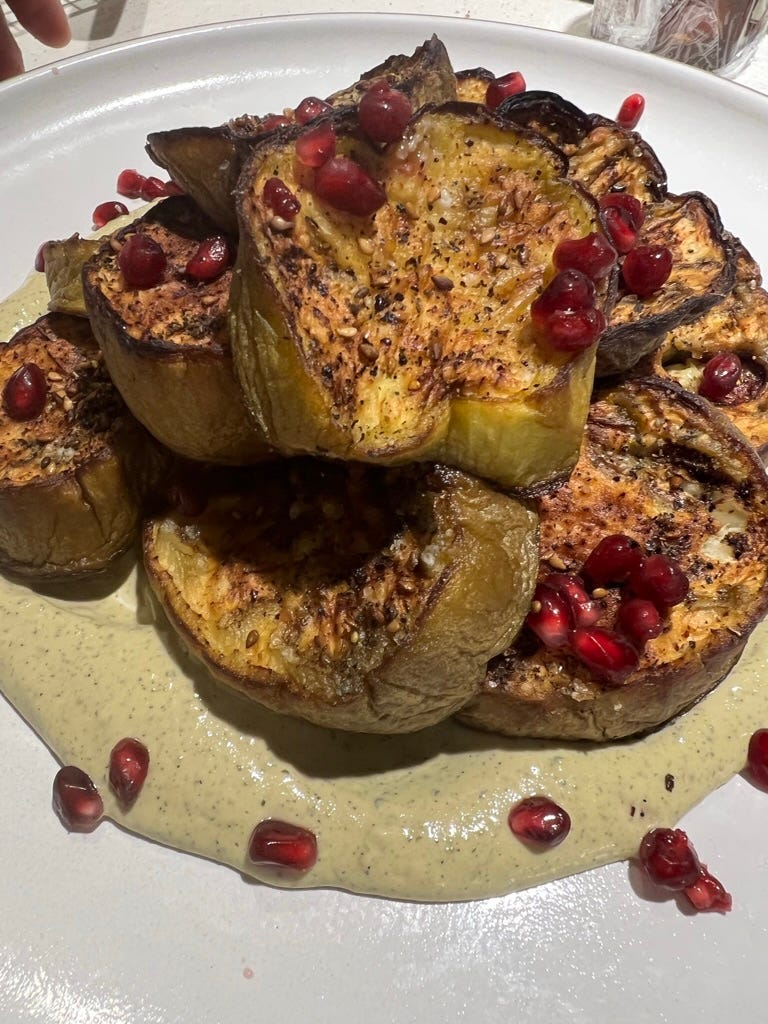
RECIPE: Roasted Eggplant with Za’atar on Tahini
2 medium eggplants (about 2 pounds)
1/2 cup or more extra-virgin olive oil
Salt
Freshly ground pepper
1 tablespoon za’atar
1/3 cup tahini
1/2 small clove garlic, grated to a paste on a Microplane
Juice of 1 lemon
1/3 cup water
Pomegranate seeds, for garnish (optional)
Preheat the oven to 400°F. Line a sheet pan with parchment paper. You can opt to peel the eggplant entirely (which I did) or strip away just a few lines of skin for texture and flavor (as described above). Trim the tops and bottoms of the eggplants and then cut them crosswise into 1 1/2”-thick disks. Arrange the disks on the sheet pan with enough space around them to roast evenly. I like to place my oil on the pan, and then using a big kitchen brush, generously brush the eggplant on all sides. Eggplant slices are like little oil sponges. If you pour oil on them they will absorb it all. So, brush quickly but liberally all around to coat. I put the oil on the pan to catch any drips, which I also use to coat the slices. When done brushing, remove the oil vessel. Generously season the eggplant with salt and pepper and set in the preheated oven to roast.
Roast the eggplant until browned and soft. The time this will take can vary considerably. Mine have been done in as little as 25 minutes, or as long as an hour. Better to err on the side of overdone. Poke the center with a fork to make sure it’s soft. Just when you think they are about done, sprinkle the eggplant with the za’atar and put it back in the oven for a couple of minutes to wake up the flavor. Remove from the oven and cool.
Meanwhile, in a medium bowl, combine the tahini, garlic, lemon juice, about ¼ cup of the water and a pinch of salt. Using a whisk, beat the mixture until it forms a thick paste. At first it might look like that won’t ever happen, but keep at it and the tahini will break down and create a thick sauce. You can also use an immersion or regular blender. Adjust the consistency with more water, if necessary, to make it soft and smooth, and taste to adjust the seasoning.
To serve, pool the sauce in the center of a wide serving bowl or plate with a rim, and spread it out with a rubber spatula. Arrange the roasted eggplant discs on top of the tahini and garnish with pomegranate seeds, if using.
One Last Thing that Happened on My Trip
I awoke in my hotel room in Tel Aviv early Monday morning to feel the bed shaking for a sustained period. I recall asking myself if I was dreaming but it kept shaking. Because I was up, I was texting with folks back home. I told Nate what I’d felt. I asked Naama whether Tel Aviv ever experienced seismic activity. We determined it must be from construction, which is everywhere in the city. Then Nate saw the first New York Times report of the devastating quake in Turkey and Syria, felt as far away as Israel. (Both eggplant loving countries, btw.) As we continue to learn about the historic and horrific extent of the devastation, I encourage you to offer any support you can. There’s a good list of organizations accepting donations compiled by the Times here.



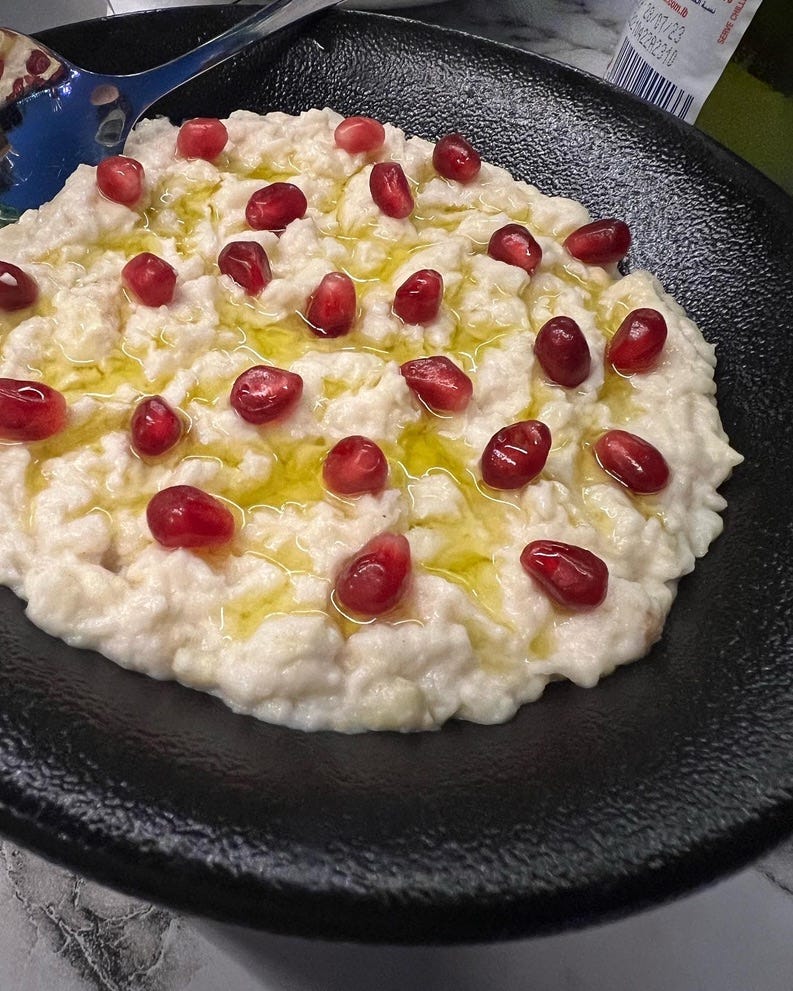

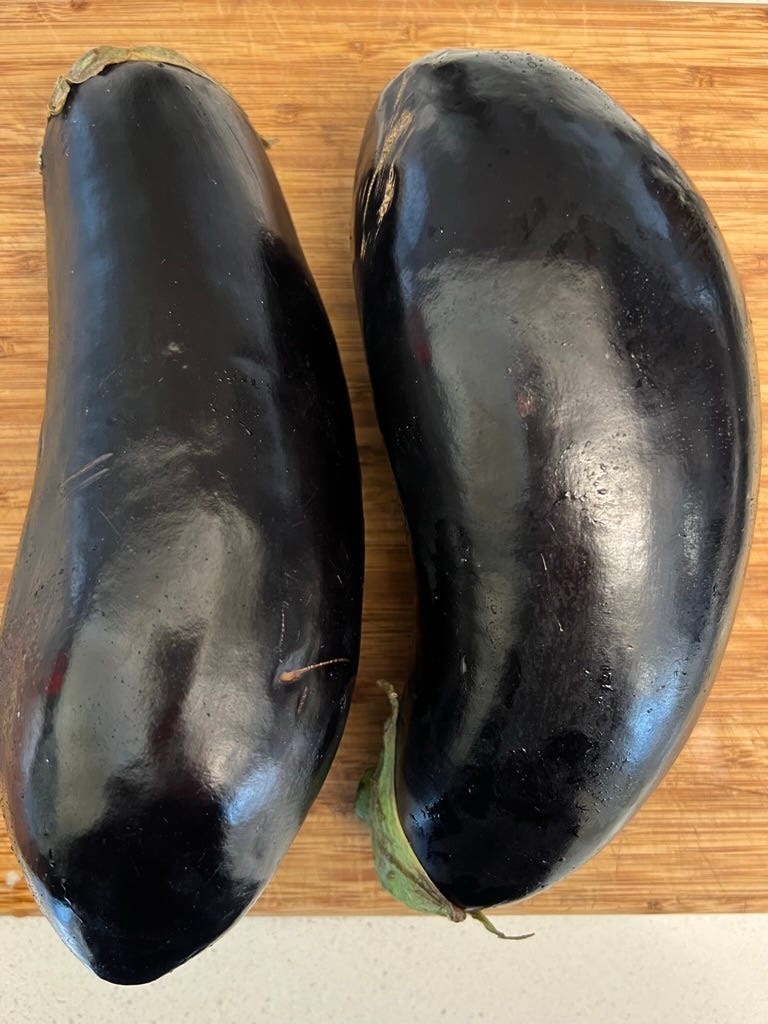
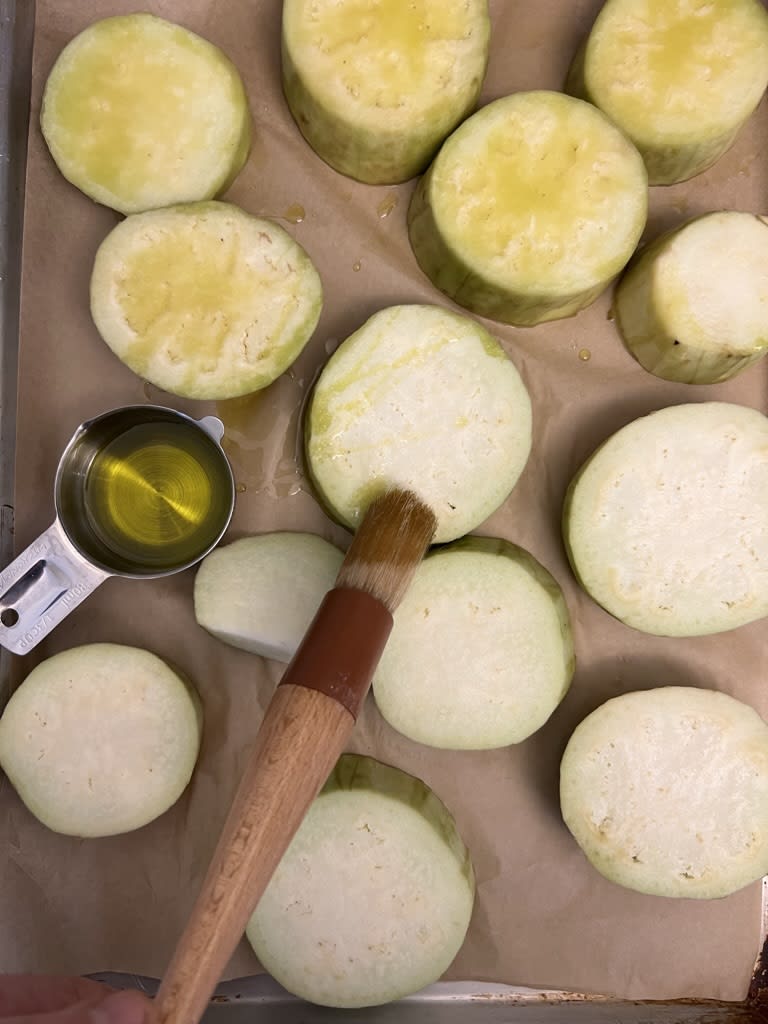
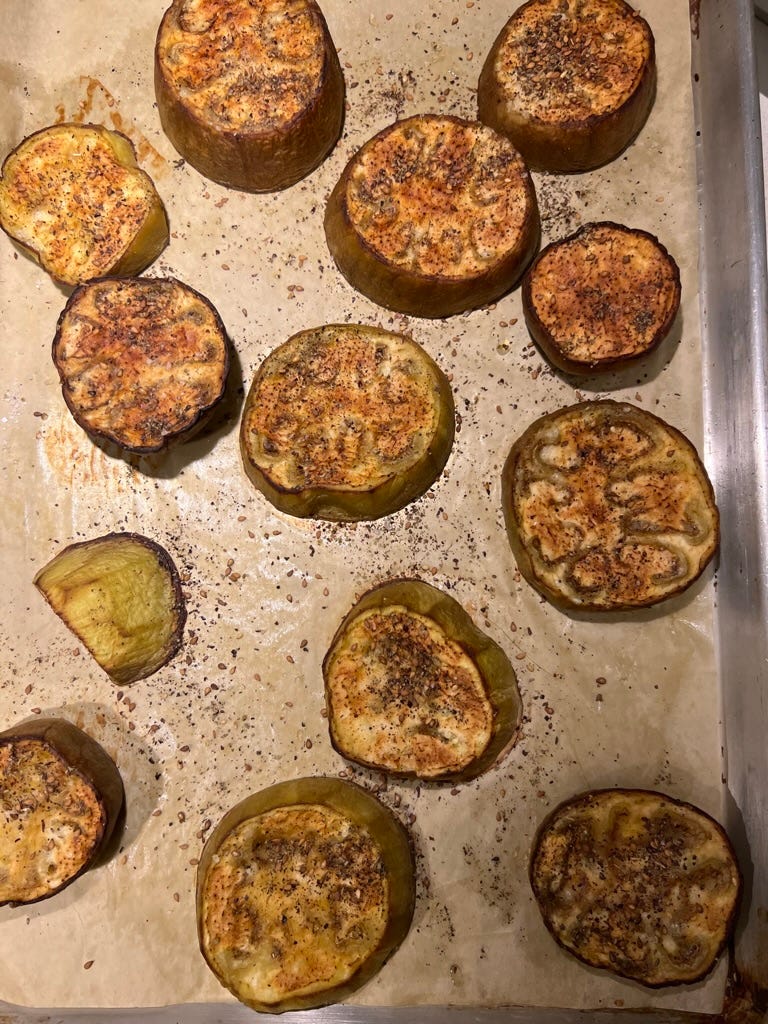
True, true, all that you say, Mitchell, but my favorite is still fresh green peas right from the garden, or even consumed in the garden, raw. And second fave has to be green beans, ditto fresh from the garden. So hard to find nowadays. But bravo for eggplant too, at least in part because it loves olive oil and so do I.